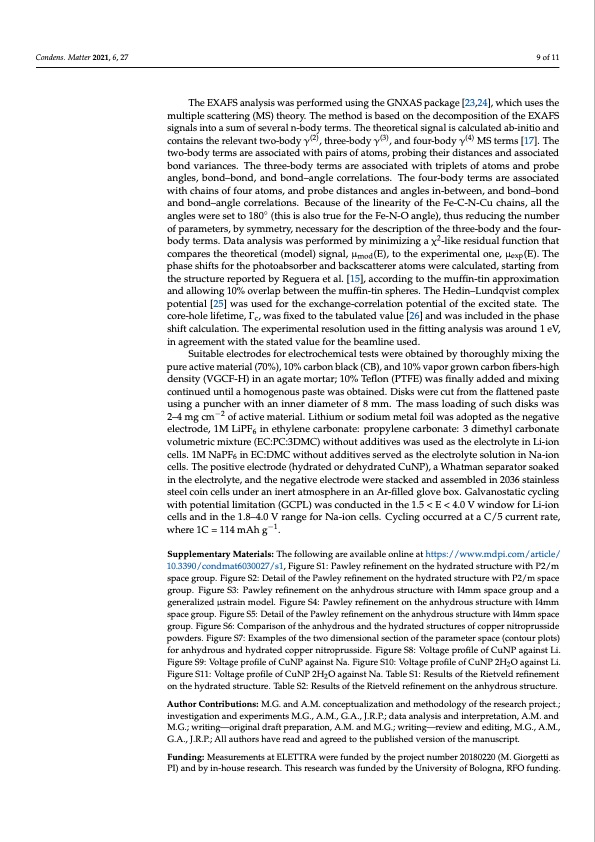
PDF Publication Title:
Text from PDF Page: 009
Condens. Matter 2021, 6, 27 9 of 11 The EXAFS analysis was performed using the GNXAS package [23,24], which uses the multiple scattering (MS) theory. The method is based on the decomposition of the EXAFS signals into a sum of several n-body terms. The theoretical signal is calculated ab-initio and contains the relevant two-body γ(2), three-body γ(3), and four-body γ(4) MS terms [17]. The two-body terms are associated with pairs of atoms, probing their distances and associated bond variances. The three-body terms are associated with triplets of atoms and probe angles, bond–bond, and bond–angle correlations. The four-body terms are associated with chains of four atoms, and probe distances and angles in-between, and bond–bond and bond–angle correlations. Because of the linearity of the Fe-C-N-Cu chains, all the angles were set to 180◦ (this is also true for the Fe-N-O angle), thus reducing the number of parameters, by symmetry, necessary for the description of the three-body and the four- body terms. Data analysis was performed by minimizing a χ2-like residual function that compares the theoretical (model) signal, μmod(E), to the experimental one, μexp(E). The phase shifts for the photoabsorber and backscatterer atoms were calculated, starting from the structure reported by Reguera et al. [15], according to the muffin-tin approximation and allowing 10% overlap between the muffin-tin spheres. The Hedin–Lundqvist complex potential [25] was used for the exchange-correlation potential of the excited state. The core-hole lifetime, Γc, was fixed to the tabulated value [26] and was included in the phase shift calculation. The experimental resolution used in the fitting analysis was around 1 eV, in agreement with the stated value for the beamline used. Suitable electrodes for electrochemical tests were obtained by thoroughly mixing the pure active material (70%), 10% carbon black (CB), and 10% vapor grown carbon fibers-high density (VGCF-H) in an agate mortar; 10% Teflon (PTFE) was finally added and mixing continued until a homogenous paste was obtained. Disks were cut from the flattened paste using a puncher with an inner diameter of 8 mm. The mass loading of such disks was 2–4 mg cm−2 of active material. Lithium or sodium metal foil was adopted as the negative electrode, 1M LiPF6 in ethylene carbonate: propylene carbonate: 3 dimethyl carbonate volumetric mixture (EC:PC:3DMC) without additives was used as the electrolyte in Li-ion cells. 1M NaPF6 in EC:DMC without additives served as the electrolyte solution in Na-ion cells. The positive electrode (hydrated or dehydrated CuNP), a Whatman separator soaked in the electrolyte, and the negative electrode were stacked and assembled in 2036 stainless steel coin cells under an inert atmosphere in an Ar-filled glove box. Galvanostatic cycling with potential limitation (GCPL) was conducted in the 1.5 < E < 4.0 V window for Li-ion cells and in the 1.8–4.0 V range for Na-ion cells. Cycling occurred at a C/5 current rate, where 1C = 114 mAh g−1. Supplementary Materials: The following are available online at https://www.mdpi.com/article/ 10.3390/condmat6030027/s1, Figure S1: Pawley refinement on the hydrated structure with P2/m space group. Figure S2: Detail of the Pawley refinement on the hydrated structure with P2/m space group. Figure S3: Pawley refinement on the anhydrous structure with I4mm space group and a generalized μstrain model. Figure S4: Pawley refinement on the anhydrous structure with I4mm space group. Figure S5: Detail of the Pawley refinement on the anhydrous structure with I4mm space group. Figure S6: Comparison of the anhydrous and the hydrated structures of copper nitroprusside powders. Figure S7: Examples of the two dimensional section of the parameter space (contour plots) for anhydrous and hydrated copper nitroprusside. Figure S8: Voltage profile of CuNP against Li. Figure S9: Voltage profile of CuNP against Na. Figure S10: Voltage profile of CuNP 2H2O against Li. Figure S11: Voltage profile of CuNP 2H2O against Na. Table S1: Results of the Rietveld refinement on the hydrated structure. Table S2: Results of the Rietveld refinement on the anhydrous structure. Author Contributions: M.G. and A.M. conceptualization and methodology of the research project.; investigation and experiments M.G., A.M., G.A., J.R.P.; data analysis and interpretation, A.M. and M.G.; writing—original draft preparation, A.M. and M.G.; writing—review and editing, M.G., A.M., G.A., J.R.P.; All authors have read and agreed to the published version of the manuscript. Funding: Measurements at ELETTRA were funded by the project number 20180220 (M. Giorgetti as PI) and by in-house research. This research was funded by the University of Bologna, RFO funding.PDF Image | Cross-Investigation on Copper Nitroprusside: Combining XRD and XAS

PDF Search Title:
Cross-Investigation on Copper Nitroprusside: Combining XRD and XASOriginal File Name Searched:
condensedmatter-06-00027-v2.pdfDIY PDF Search: Google It | Yahoo | Bing
Sulfur Deposition on Carbon Nanofibers using Supercritical CO2 Sulfur Deposition on Carbon Nanofibers using Supercritical CO2. Gamma sulfur also known as mother of pearl sulfur and nacreous sulfur... More Info
CO2 Organic Rankine Cycle Experimenter Platform The supercritical CO2 phase change system is both a heat pump and organic rankine cycle which can be used for those purposes and as a supercritical extractor for advanced subcritical and supercritical extraction technology. Uses include producing nanoparticles, precious metal CO2 extraction, lithium battery recycling, and other applications... More Info
| CONTACT TEL: 608-238-6001 Email: greg@infinityturbine.com | RSS | AMP |